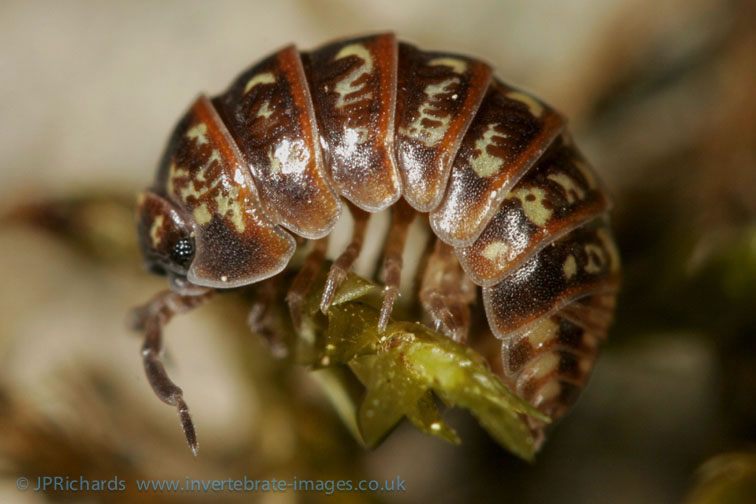Armadillidium pulchellum (Zenker in Panzer, 1799)
Common name
Status:
GB IUCN status: Least Concern
ID Difficulty
Identification
Our seven Armadillidium species and Eluma caelata (Family Armadillidiidae) are readily recognised in the field by their truncated 'square' uropods that end flush with the body and their ability to roll into a protective sphere (similar truncated uropods are also seen in the non-native Armadillidae species).
Armadillidium pulchellum is a small (to 5 mm body length) attractively mottled pill-woodlouse. It shares its distinctive mottling and the dark patch on the 7th epimera with A. pictum (a larger species). There is considerable overlap in the distribution and habitat preferences of A. pulchellum and A. pictum and the two are easily confused. The shape of the male first pleopods in diagnostic, but females are more tricky. A. vulgare immatures are never as attractively mottled and lack the dark patch on the 7th epimera.
A guide to identification of these three species is given by Gregory & Richards (2008).
Distribution
This pill woodlouse is widely distributed across the Irish midlands and across Britain from south-west England, through Wales and across northern England to the Scottish borders (as far north as Aberdeenshire; Davidson, 2010).
Habitat
Armadillidium pulchellum favours rural semi-natural habitats, often associated with open grassy habitats, mainly on the coast or in upland areas, including limestone pavement. In lowland south-east England the few known populations are from relict heathland.
It occurs under stones or mats of plants, among sparsely vegetated screes, leaf litter, grasses, mosses, sometimes associated with ants (rarely within rotten wood, such as pine stumps).
This summary is based on the detailed account in Gregory (2009).
References
Gregory, S. (2009) Woodlice and Waterlice (Isopoda: Oniscidea & Asellota) in Britain and Ireland. Field Studies Council/Centre for Ecology & Hydrology.
Gregory, S. & Richards, P. (2008) Comparison of three often mis-identified species of pill-woodlouse Armadillidium (Isopoda: Oniscidea). Bulletin of the British Myriapod & Isopod Group, 23: 9-12.
Links
World List of Marine, Freshwater and Terrestrial Isopod Crustaceans: https://www.marinespecies.org/isopoda/aphia.php?p=taxdetails&id=257781













